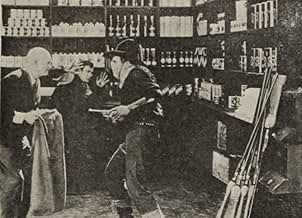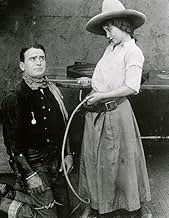PUNTUACIÓN EN IMDb
6,6/10
296
TU PUNTUACIÓN
Añade un argumento en tu idiomaAn outlaw calling himself Passin' Through halts his "evil" ways long enough to help out some children in difficulty.An outlaw calling himself Passin' Through halts his "evil" ways long enough to help out some children in difficulty.An outlaw calling himself Passin' Through halts his "evil" ways long enough to help out some children in difficulty.
Argumento
¿Sabías que...?
- CuriosidadesRestored May 2014 by San Francisco Silent Film Festival, Cinematheque Francaise, and the Film Preservation Society.
- Citas
"Swappin' Stories" Cowboy: Queer cuss! He makes a specialty of helpin' kids that's born in shame.
- ConexionesFeatured in Douglas Fairbanks: Je suis une légende (2018)
Reseña destacada
This newly restored Douglas Fairbanks feature has been screened at two festivals this year, the San Francisco Silent Film festival and 'Mostly Lost 3' in Culpeper, Virginia. I saw it on the latter occasion, and it's a pleasure to report that this is a terrific movie, and a significant addition to the Fairbanks canon. Originally produced for the Fine Arts Corporation, and released by Triangle in the spring of 1916, The Good Bad Man marked a venture into unusual territory for the star at this juncture in his career, when his vehicles tended to be breezy comedies with modern settings. Although there are some comic moments, The Good Bad Man is a straightforward Western with a serious theme, closer in tone to a William S. Hart production than it is to a typical Fairbanks romp of the mid-1910s, such as His Picture in the Papers or The Matrimaniac. The star wrote the screenplay himself, and gives an unusually impassioned performance, which suggests that this project was close to his heart.
Doug plays a good natured drifter who calls himself "Passin' Through." He's an outlaw but not a bad guy, for he never hurts anyone when he commits his robberies, nor does he take anything of great monetary value, such as jewelry. He collects trinkets for himself, just whimsical souvenirs really, but makes a point of taking food and other goods for children who truly need assistance. Passin' Through has a special interest in helping orphans and fatherless boys, and we learn that he struggles with what we call "father issues" nowadays. It seems that his father died before he got a chance to know him, and he harbors doubts that his parents were legally married when he was born. (In reality Fairbanks's father was a drunkard who abandoned his family when Doug was a small boy; the star's real-life father issues may account for his choice of material here, as well as the notable intensity of his performance.) As the story begins, Passin' Through arrives in a frontier town and almost immediately butts heads with the local crime boss, a mean-spirited crook known as The Wolf. He gets himself into trouble and is arrested, but with the help of a kindly lawman our hero learns the truth about his parents, and the role The Wolf played in his father's death, and eventually gains an advantage over the villain and avenges himself.
That's the gist of the plot, but what makes this film special isn't the story so much as the performances, as well as the visual aspects of the production. Doug has a nice rapport with leading lady Bessie Love, who was still a teenager when she appeared in this film, and cute as a bug. Their first scene together concludes with a memorable detail: as Passin' Through takes his leave of his new love interest, he suddenly produces a train conductor's ticket-punch, and pops a little hole in a ribbon that's part of her outfit. It's as if he's claimed her, or marked her as "his." She's startled for a moment, but appears to have no objections. In addition to the charming scenes between Doug and Bessie, what's most striking about this film are the beautifully scenic desert locations, and the climactic shots of riders—an impressive number of them—on horseback, galloping across the landscape. Director Allan Dwan, who worked with Fairbanks several times, handles the action scenes deftly, while cameraman Victor Fleming (who, of course, went on to become an estimable director in his own right) makes a major contribution: the cinematography is beautiful.
We're lucky the film looks so good. In fact, we're lucky we can see it at all, when we consider how many silent movies are lost. For decades The Good Bad Man was believed to be among the missing, but in recent years a 35mm print was located at the Cinémathèque Française, and this is the one that's been restored and shown at the aforementioned festivals. At 'Mostly Lost' the screening was introduced by Rob Byrne of the San Francisco Silent Film Festival, who showed us examples of footage before and after the restoration. He also explained that what survives is not the original 1916 release, but rather a reissue from 1923, which was re-edited and reworked in minor ways. (For instance, Bessie Love's character Amy was renamed Sarah May.) In any case, it's a pleasure to see a "new" Douglas Fairbanks production from this early, crucial period of his career. The Good Bad Man is a real treat for silent film buffs, and here's hoping it is screened widely and often in the years to come.
Doug plays a good natured drifter who calls himself "Passin' Through." He's an outlaw but not a bad guy, for he never hurts anyone when he commits his robberies, nor does he take anything of great monetary value, such as jewelry. He collects trinkets for himself, just whimsical souvenirs really, but makes a point of taking food and other goods for children who truly need assistance. Passin' Through has a special interest in helping orphans and fatherless boys, and we learn that he struggles with what we call "father issues" nowadays. It seems that his father died before he got a chance to know him, and he harbors doubts that his parents were legally married when he was born. (In reality Fairbanks's father was a drunkard who abandoned his family when Doug was a small boy; the star's real-life father issues may account for his choice of material here, as well as the notable intensity of his performance.) As the story begins, Passin' Through arrives in a frontier town and almost immediately butts heads with the local crime boss, a mean-spirited crook known as The Wolf. He gets himself into trouble and is arrested, but with the help of a kindly lawman our hero learns the truth about his parents, and the role The Wolf played in his father's death, and eventually gains an advantage over the villain and avenges himself.
That's the gist of the plot, but what makes this film special isn't the story so much as the performances, as well as the visual aspects of the production. Doug has a nice rapport with leading lady Bessie Love, who was still a teenager when she appeared in this film, and cute as a bug. Their first scene together concludes with a memorable detail: as Passin' Through takes his leave of his new love interest, he suddenly produces a train conductor's ticket-punch, and pops a little hole in a ribbon that's part of her outfit. It's as if he's claimed her, or marked her as "his." She's startled for a moment, but appears to have no objections. In addition to the charming scenes between Doug and Bessie, what's most striking about this film are the beautifully scenic desert locations, and the climactic shots of riders—an impressive number of them—on horseback, galloping across the landscape. Director Allan Dwan, who worked with Fairbanks several times, handles the action scenes deftly, while cameraman Victor Fleming (who, of course, went on to become an estimable director in his own right) makes a major contribution: the cinematography is beautiful.
We're lucky the film looks so good. In fact, we're lucky we can see it at all, when we consider how many silent movies are lost. For decades The Good Bad Man was believed to be among the missing, but in recent years a 35mm print was located at the Cinémathèque Française, and this is the one that's been restored and shown at the aforementioned festivals. At 'Mostly Lost' the screening was introduced by Rob Byrne of the San Francisco Silent Film Festival, who showed us examples of footage before and after the restoration. He also explained that what survives is not the original 1916 release, but rather a reissue from 1923, which was re-edited and reworked in minor ways. (For instance, Bessie Love's character Amy was renamed Sarah May.) In any case, it's a pleasure to see a "new" Douglas Fairbanks production from this early, crucial period of his career. The Good Bad Man is a real treat for silent film buffs, and here's hoping it is screened widely and often in the years to come.
- wmorrow59
- 13 sept 2014
- Enlace permanente
Selecciones populares
Inicia sesión para calificar y añadir a tu lista para recibir recomendaciones personalizadas
Detalles
- Fecha de lanzamiento
- País de origen
- Idiomas
- Títulos en diferentes países
- The Good Bad-Man
- Localizaciones del rodaje
- Mojave, California, Estados Unidos(Exterior)
- Empresa productora
- Ver más compañías en los créditos en IMDbPro
- Duración50 minutos
- Color
- Mezcla de sonido
- Relación de aspecto
- 1.33 : 1
Contribuir a esta página
Sugerir un cambio o añadir el contenido que falta

Principal laguna de datos
By what name was El ladrón generoso (1916) officially released in Canada in English?
Responde


























